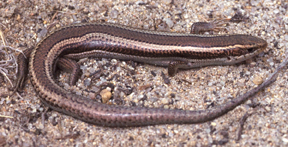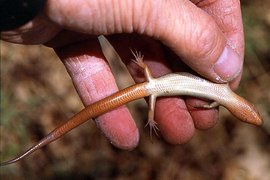Western Skink
|
|
| Western Skink | ||||||||||||||||
|---|---|---|---|---|---|---|---|---|---|---|---|---|---|---|---|---|
 | ||||||||||||||||
| Scientific classification | ||||||||||||||||
| ||||||||||||||||
| Binomial name | ||||||||||||||||
| Eumeces skiltonianus (Baird and Girard,, 1852) |
The Western Skink (Eumeces skiltonianus) is a small, smooth-scaled lizard with relatively small limbs, measuring about 5 to 8 cm (2 to 3 inches) from snout to vent. It is one of five species of lizards in Canada.
Taxonomy
Baird and Girard described Skilton's Skink in 1852 and named it in honor of one Dr. Avery J. Skilton, who had sent them specimen of the species. Tanner (1957) identified the subspecies interparietalis and utahensis.
There are several subspecies:
- Coronado Skink (E.s. interparietalis) (occurs in southern California and Baja California, Mexico)
- Great Basin Skink (E.s. utahensis) (occurs in Utah)
- Skilton's Skink (E.s. skiltonianus)
The most common is Skilton's Skink, which occurs throughout the western United States west of the Rocky Mountains and in southern British Columbia, Canada.
Together with the Gilbert's Skink (E. gilberti), the San Lucan Skink (E. lagunensis), and the Four-lined Asiatic Skink (E. quadrilineatus), the Western Skink belongs to the so-called "skiltonianus group". The exact taxonomy within this group is being questioned and may need revision following DNA analysis research.
Description
The Western Skink is a secretive and very agile lizard that forages actively through leaf litter and dense vegetation, preying upon small invertebrates. It is a good burrower and sometimes constructs burrows several times its own body length.
Found in a variety of habitats from sea level to at least 2130 m (7000 ft), the Western Skink is commonest in early successional stages or open areas within habitats in which it occurs. Heavy brush and densely forested areas are generally avoided. The Western Skink seems to prefer a somewhat moist environment, although it can also be found on dry hillsides. The soil of its nest chambers is invariably moist. Standing water is apparently not required.
The Western Skink is brown in color and has four white or beige stripes, two on the back an one on each side. Juveniles have bright blue tails.
Life History
This skink is diurnal during the period of warm-season activity. During summer most activity is concentrated in the morning and late afternoon. Where summer temperatures are not extreme, activity extends throughout the day. Adult skinks usually become inactive by early fall but juveniles extend their period of activity several weeks.
The reproductive season for this species varies geographically and from year to year depending on local conditions. Mating probably occurs in the spring soon after emergence. Males turn orange on the underside when they are breeding. Females lay 2-6 eggs during June and July in nest chambers constructed in loose, moist soil under rocks, logs, or other cover.
Young Western Skinks probably hatch in late summer, and sexual maturity may occur at 2 years of age, but most individuals probably do not reproduce until they are 3 years old. Western Skinks can reach an age of about 5 or 6 years.
References
- The Western Skink (http://www.catalinaconservancy.org/ecology/research/richmond.asp)
- The Western Skink (http://www.dfg.ca.gov/whdab/html/R036.html) at the California Department of Fish and Game.
- The Coronado Skink (http://www.dfg.ca.gov/hcpb/cgi-bin/read_one.asp?specy=reptiles&idNum=23) at the California Department of Fish and Game.
Selected literature
- Tanner, W. W. (1957): A taxonomic and ecological study of the western skink (Eumeces skiltonianus). Great Basin Nat. 17: 59-94.


